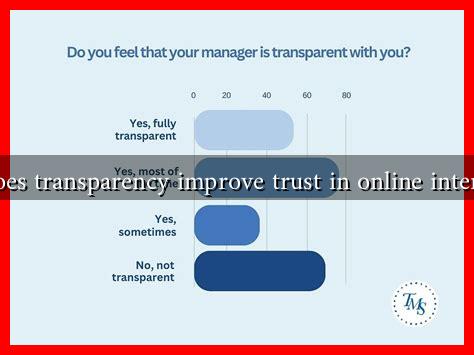-
Table of Contents
- How Does Transparency Improve Trust in Online Interactions?
- The Role of Transparency in Building Trust
- Case Studies: Successful Transparency in Action
- 1. Buffer
- 2. Patagonia
- The Impact of Transparency on Consumer Behavior
- Challenges to Achieving Transparency
- Best Practices for Enhancing Transparency
- Conclusion
How Does Transparency Improve Trust in Online Interactions?
In an increasingly digital world, the importance of trust in online interactions cannot be overstated. Whether it’s e-commerce, social media, or online services, users are more likely to engage with platforms that exhibit transparency. This article explores how transparency fosters trust in online interactions, supported by examples, case studies, and relevant statistics.
The Role of Transparency in Building Trust
Transparency refers to the openness and clarity with which information is shared. In online interactions, transparency can take various forms, including clear communication, honest marketing practices, and the disclosure of data usage policies. Here are some key ways transparency enhances trust:
- Clear Communication: When companies communicate openly about their products, services, and policies, it reduces ambiguity and builds confidence among users.
- Accountability: Transparent organizations are more likely to take responsibility for their actions, which fosters a sense of reliability.
- Data Privacy: In an era where data breaches are common, being transparent about data collection and usage can significantly enhance user trust.
Case Studies: Successful Transparency in Action
Several companies have successfully implemented transparency strategies that have led to increased trust and customer loyalty. Here are a few notable examples:
1. Buffer
Buffer, a social media management platform, is renowned for its transparency. The company openly shares its revenue, employee salaries, and even its decision-making processes. This level of openness has not only built trust with its users but has also attracted top talent who appreciate the company’s commitment to transparency.
2. Patagonia
Patagonia, an outdoor clothing brand, is another excellent example. The company is transparent about its supply chain practices and environmental impact. By openly discussing its efforts to reduce carbon emissions and promote fair labor practices, Patagonia has cultivated a loyal customer base that trusts its brand values.
The Impact of Transparency on Consumer Behavior
Research indicates that transparency significantly influences consumer behavior. According to a study by the Harris Poll, 73% of consumers are more likely to purchase from a brand that is transparent about its business practices. Furthermore, 67% of consumers stated that they would be more loyal to a brand that openly shares information about its products and services.
Challenges to Achieving Transparency
While transparency is beneficial, it is not without its challenges. Organizations may face several hurdles, including:
- Fear of Backlash: Companies may hesitate to disclose negative information due to fear of public backlash or loss of reputation.
- Complexity of Information: Some organizations struggle to present complex information in a way that is easily understandable to consumers.
- Regulatory Constraints: Legal and regulatory frameworks may limit the extent to which companies can share certain information.
Best Practices for Enhancing Transparency
To effectively enhance transparency and build trust, organizations can adopt the following best practices:
- Regular Updates: Keep users informed about changes in policies, products, and services through regular updates.
- Open Dialogue: Encourage feedback and create channels for open communication with users.
- Clear Policies: Ensure that privacy policies and terms of service are written in clear, accessible language.
Conclusion
In conclusion, transparency plays a crucial role in building trust in online interactions. By fostering clear communication, accountability, and openness about data practices, organizations can create a trustworthy environment for users. The examples of companies like Buffer and Patagonia illustrate that transparency not only enhances consumer trust but also drives loyalty and engagement. As the digital landscape continues to evolve, prioritizing transparency will be essential for businesses aiming to thrive in a competitive market.

